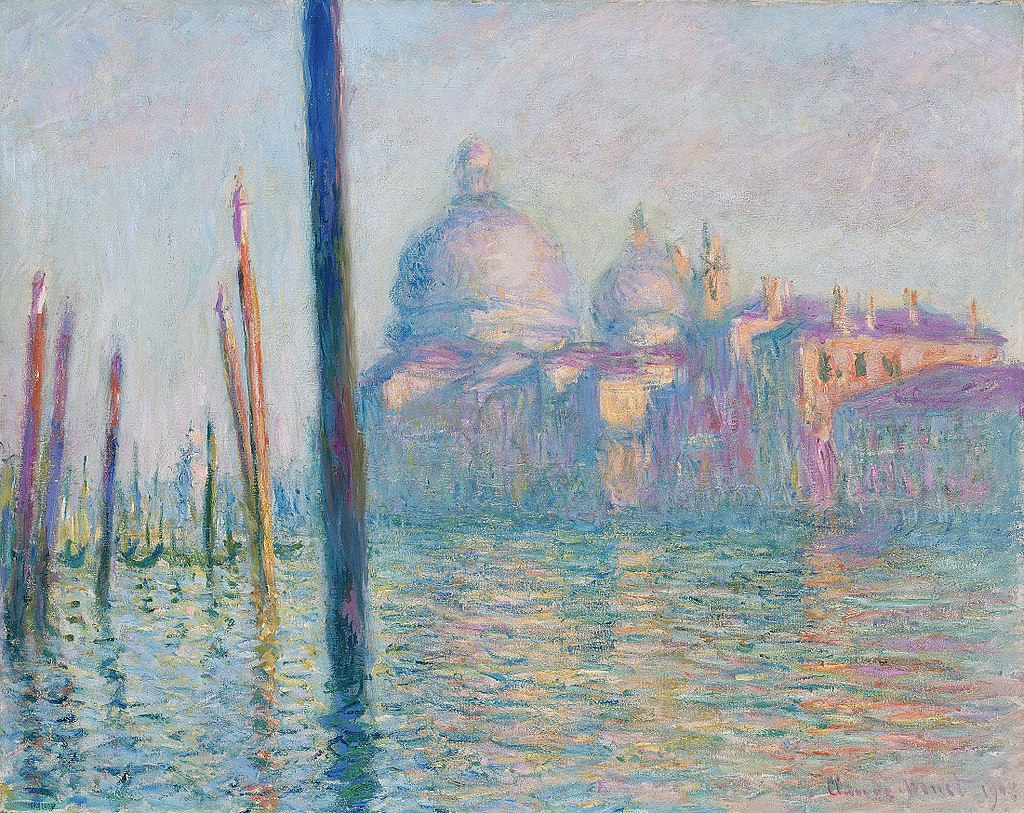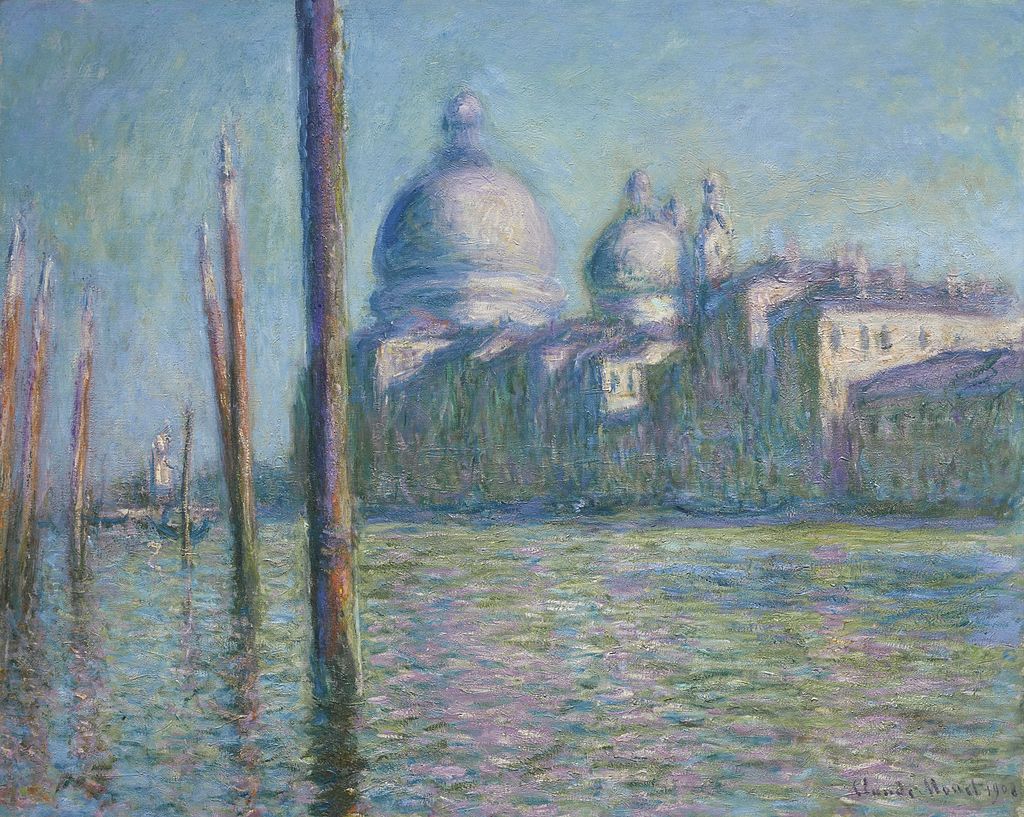|
Where? Gallery 252 of the Museum of Fine Arts
When? 1908 What do you see? A view down the Grand Canal in Venice in the middle of the afternoon. On the left is a series of mooring poles were boats can park. At the end of the canal is the Santa Maria della Salute Church. The church has two large domes and a tower, but Monet is more interested in painting the effects of light and the water. Monet uses red, orange, purple, and pink tones for the church, and he adds green tones to the water. In the green and blue water, we can see the reflections of the church and the adjoining buildings on the right. Backstory: The Grand Canal is the major waterway that goes through the middle of Venice. Claude Monet painted this painting of the Grand Canal and the Santa Maria della Salute Church from a spot near the Palazzo Barbaro. This palazzo was owned by a Mary Young Hunter, a relative of the American Impressionist painter John Singer Sargent, who had introduced her to Monet’s wife. Over the years, several Impressionist painters, including Monet, were allowed to stay at this place and work on their paintings. Santa Maria della Salute: The Catholic Santa Maria della Salute Church in Venice is popularly known as the Salute. The church was dedicated to Our Lady of Health and was built to commemorate the end of a catastrophic outbreak of the plague in Venice in 1630. Its impressive dome is an iconic aspect of the skyline of Venice. Not only Monet was inspired by the sight of this church; also artists like Canaletto, Sargent, and Turner included this church in their works. Other versions: Monet painted six versions of The Grand Canal, Venice during this time in Venice. Monet wanted to paint the same view at the same time of the day, but capture the variations in the weather which would, in turn, lead to different light conditions. Thus, while the outline of the six paintings is the same, the light effects differ. The first picture below is the version in the Legion of Honor Museum in San Francisco. The second picture below is a version that is part of a private collection. Another one of the six versions was sold in 2015 for $35.6 million.
Who is Monet? Claude Monet was born in 1840 in Paris and died in 1926 in Giverny, about 45 miles West of Paris. He was one of the founders of Impressionism. At the beginning of his career, his works were not positively received by many people. But he continued to develop his Impressionist style. One of the paintings he created during this time was Woman with a Parasol - Madame Monet and Her Son in the National Gallery of Art.
Eventually, Monet became a very successful painter who was able to sell most of his works for good prices. With the money that he earned, he bought a house in Giverny where he created a beautiful large garden where he could spend much time painting in the outdoors. One of the paintings he created in his garden was The Japanese Footbridge and the Water Lily Pool, Giverny in the Philadelphia Museum of Art.
Fun fact: Claude Monet had always told his wife that Venice was too beautiful to paint. But when a friend of Monet’s wife presented them with the opportunity to visit the city and stay at her house with a beautiful view, they could not refuse. During his first week in Venice, Monet was still of the opinion that Venice was too beautiful to paint, but after that first week, he could no longer retain himself.
During his almost 2.5 months in Venice in the Fall of 1908, Monet painted a total of 37 works of Venice, including the six versions of The Grand Canal, Venice. He painted the first part of these works en plein air (outside) and completed the paintings in his studio in Giverny. While he immediately sold 28 of the 37 paintings to a dealer after he got back to France, it would take him three more years to complete the paintings. Interested in a copy for yourself? Poster
Written by Eelco Kappe
References:
0 Comments
Leave a Reply. |
Categories
All
|
- Home
- Blog
-
Museums
- Alte Pinakothek
- Art Institute of Chicago
- Baltimore Museum of Art
- Barber Institute of Fine Arts
- Bargello
- Barnes Foundation
- British Museum
- Church of Sant’Anastasia
- Cleveland Museum of Art
- Courtauld Institute of Art
- Detroit Institute of Arts
- Frans Hals Museum
- Galleria Borghese
- Gallerie dell'Accademia
- Getty Museum
- Guggenheim
- Hermitage Museum
- Kunsthistorisches Museum
- Kunstmuseum Basel
- Legion of Honor Museum
- Louvre
- Mauritshuis
- Metropolitan Museum of Art
- Musee d’Orsay
- Museum of Fine Arts in Boston
- Museum of Modern Art
- National Gallery in London
- National Gallery of Art
- National Museum in Poznań
- Norton Simon Museum
- Ny Carlsberg Glyptotek
- Palace of Versailles
- Palazzo Pitti
- Palazzo Vecchio
- Petit Palais
- Philadelphia Museum of Art
- Prado
- Pushkin Museum
- Ravenna Art Museum
- Rijksmuseum
- San Diego Museum of Art
- Santa Maria delle Grazie
- St. Peter's Basilica
- Städel Museum
- Statens Museum for Kunst
- Tate Britain
- Tate Modern
- Timken Museum of Art
- Uffizi
- Vatican Museums
- Wallace Collection
-
Artists
- Altdorfer
- Anguissola
- Berlin Painter
- Bosch
- Botticelli
- Boucher
- Bronzino
- Bruegel the Elder
- Brunelleschi
- Cabanel
- Caillebotte
- Canova
- Caravaggio
- Carpeaux
- Cezanne
- Cimabue
- David
- Degas
- Delacroix
- De Maria
- Donatello
- El Greco
- Fontana
- Fra Angelico
- Fragonard
- Gauguin
- Gentileschi
- Gericault
- Gonzalez-Torres
- Goya
- Hals
- Hogarth
- Hokusai
- Ingres
- Leonardo da Vinci
- Lippi, Filippo
- Longhi, Barbara
- Lorrain
- Makovsky
- Manet
- Massys
- Matisse
- Merian
- Michelangelo
- Mochi
- Modigliani
- Monet
- Panini
- Parmigianino
- Perugino
- Picasso
- Pisanello
- Raphael
- Rembrandt
- Renoir
- Reynolds
- Rivera
- Rodin
- Rubens
- Scultori
- Seurat
- Steen
- Tintoretto
- Titian
- Toulouse-Lautrec
- Turner
- Uccello
- Van der Weyden
- Van Dyck
- Van Eyck
- Van Gogh
- Van Hemessen
- Vasari
- Velazquez
- Vermeer
- Veronese
- Vigée Le Brun
-
Locations
- Books
- About Us





